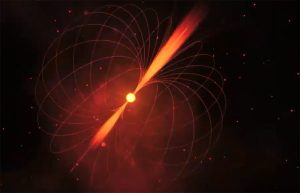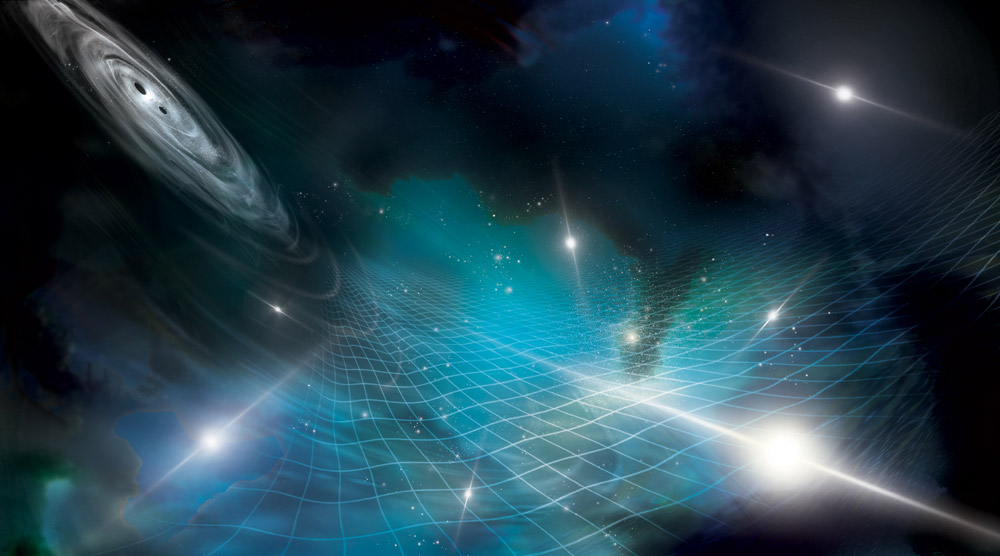Omnipresent vibrations: The entire universe is filled with invisible waves stretching out for many light years – the gravitational wave background. Now astronomers have detected these long waves of oscillations in space-time for the first time. In contrast to the very short, high-pitched signals from the collisions of stellar black holes, these giant oscillations are like a continuous “hum.” Researchers discovered them through long-term observations of pulsars, whose radio pulses are deflected by gravitational waves.
As early as 1916, Albert Einstein predicted that the motion of massive cosmic bodies causes space-time to oscillate. In 2015, astronomers were able to detect gravitational waves from a merged pair of stellar black holes for the first time. They have since discovered a complete “periodic table” of such events. Translated into acoustic terms, the short-range, high-frequency oscillations in space and time of such collisions of neutron stars or black holes are like a short whistling or chirp.
Continuous buzz instead of short beeps
But astrophysicists have long suspected that in addition to these very short, sporadic events there must also be long-duration, long-wave gravitational waves in the universe. A single oscillation of such a wave can span several light years. Such extremely low-frequency oscillations in space and time arise when, for example, binaries or triples of supermassive black holes interact with each other. Because these giants weigh several million to billions of solar masses, they release huge amounts of energy in the form of long-wavelength gravitational waves.
Other waves of this type may be from the early days of the universe or even represent echoes of the Great Bounce – the collapse of the former universe before the Big Bang. All of these vibrations combine to create an omnipresent background of vast but invisible gravitational waves – a “ground noise” or “hum” everywhere in the moving space-time. This vibrating background forms the gravitational counterpart to the cosmic background radiation, which fills the entire universe with faint radio noise.
Pulsars as research aids
But the problem is that to detect a gravitational wave with a wavelength of several light years, you need a detector the size of half a galaxy — and for a long time. Therefore, astronomers took advantage of cosmic “helpers” to search for these giant vibrations. The collaboration used the now-destroyed North American Nanohertz Gravitational-Wave Observatory (NANOGrav) the Arecibo radio telescope, the Green Bank telescope in West Virginia, and the Very Large Array in New Mexico.
Using these large radio telescopes, astronomers have repeatedly targeted 67 pulsars in our galaxy over the course of 15 years. Pulsars are neutron stars that rotate rapidly on their axis, emitting a focused beam of radio waves like a kind of cosmic beacon. These pulsars, when seen from Earth, emit fast but very regular radio pulses – like a cosmic accelerator.

Minor changes in clock speed
This is where long-wave gravitational waves come into play: as they stretch and compress the space-time between us and the pulsar, this also changes the travel time of the radio pulsars – and creates small anomalies in their “regular beats.” Over the course of several years, you must track these Aberrations form space-time oscillations.
“Pulsars are relatively faint radio sources, so it took us thousands of hours of observation time annually in some of the largest telescopes in the world to do this experiment,” says Maura McLaughlin of West Virginia University. In 2020, after twelve years of pulsar observations, researchers are actually starting to see the first signs of the gravitational waves they have been looking for. Now, after 15 years of collecting data, the NANOGrav teams have confirmed that suspicion.
“Gravity Wave Universe Music”
“We now know that it’s actually the music of the gravitational wave universe,” says Xavier Siemens of Oregon State University. The clock fluctuations of pulsars distributed across the Milky Way indicate that the entire universe is filled with the “hum” of these long-wavelength space-time oscillations. “This is the first detection of the gravitational-wave background, and we’ve opened up a whole new observational window into the universe,” says Chiara Mingarelli of the Flatiron Institute in New York City.
Astronomers hypothesize that a large part of the space-time oscillations they observe can be traced back to the interaction of orbiting supermassive black holes – as predicted by theory. The frequency of gravitational waves emitted in the process depends, among other things, on the mass and motion of the black holes. “It’s like a choir that all these black holes join at different frequencies,” Mingarelli explains.
Louder than expected
But surprisingly, Mingarelli says, “the gravitational-wave background is twice as high as expected.” “It moves at the upper limit of what vibration models predict only for such black holes.” So the researchers suspect that other processes could also be contributing to this boisterous chorus of space-time vibrations. What these are, however, remains unclear. So far, the data has only shown the aggregated “buzz” of all potential sources.
The goal of the NANOGrav collaboration is now to learn more about the individual sources of the gravitational-wave background. So the researchers plan to evaluate their data to determine which frequencies are represented in this tinnitus and look for clues about the source of the individual oscillations. “We’re only beginning here,” Mingarelli says.
Aggregate data can reveal more
Useful: NANOGrav astronomers aren’t the only ones who have found evidence of the gravitational wave background with the help of radio telescopes and pulsars. At the same time, teams in Europe, India, China and Australia have reported very similar observations in several specialized articles. As part of the International Pulsar Timing Matrix Consortium, the groups want to combine their data in the future in order to increase accuracy.
“Our combined data will be much more meaningful,” says Stephen Taylor of Vanderbilt University, leader of the NANOGrav collaboration. “We are excited to know what secrets they will reveal to us about our universe.” (The Astrophysical Journal Letters, 2023; doi: 10.3847/2041-8213/acdac6)
Source: North American Nanohertz Gravitational-Wave Observatory (NANOGrav), National Science Foundation, Simmons Foundation

“Total coffee aficionado. Travel buff. Music ninja. Bacon nerd. Beeraholic.”







More Stories
Mysterious methane on Mars: NASA has a new theory
NASA: Hubble enters safety mode again
“Austria is turning into a political gravedigger”